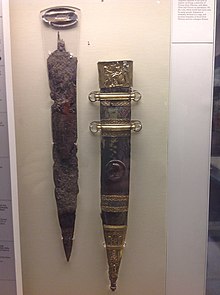Mainz Gladius
| Mainz Gladius | |
|---|---|
 The Mainz Gladius on display at the British Museum, London | |
| Material | Iron and gilded bronze |
| Size | 58 cm long |
| Created | 15 BC |
| Present location | British Museum, London |
| Registration | 1866,0806.1 |
The Mainz Gladius or Sword of Tiberius is a famous ancient Roman sword and sheath that was found in the Rhine near Mainz in Germany. Since 1866 it has been part of the British Museum's collection, when it was given to the museum by the philanthropist Felix Slade.[1] A replica of the Mainz Gladius can be found in the Romano-Germanic Central Museum (Mainz). The type of gladius was first introduced to the Romans in 20 BC.[2] Eventually the Mainz Gladius was overtaken in popularity by the Pompeii Gladius.[3]
Description[]
The sword is made of iron (now heavily corroded) and the sheath of tinned and gilded bronze. The blade was 50-55 centimetres long and 7 centimetres in width. The sword was 65 to 70 centimetres long. The sword weighed 800 grams.[4][5] The point of the sword was more triangular than the Gladius Hispaniensis.[2] The Mainz Gladius still had wasp-waisted curves. The decoration on the scabbard illustrates the ceding of military victory to Augustus by Tiberius after a successful Alpine campaign. Augustus is semi-nude, and sits in the pose of Jupiter, flanked by the Roman gods of Victory and Mars Ultor ('the Avenger'), while Tiberius, in military dress, presents Augustus with a statuette of Victory.
Ownership of the sword[]
This prestigious weapon was likely to have been commissioned by a senior officer in the Roman army to celebrate a victory in the lengthy and bloody military campaigns in Germany. Victory in these campaigns was essential for the expansion and protection of the Roman Empire's border, and the symbolic act of presenting these victories to the emperor avoided the destructive rivalry between generals which had previously brought down the Roman Republic.
References[]
- ^ British Museum Collection
- ^ a b Four Days in September: The Battle of Teutoberg Forest Revised Edition.
- ^ Loades, Mike (2010). Swords and Swordsmen. Great Britain: Pen &. ISBN 978-184-884-133-8.
- ^ Ramsay, Syed (2016). Tools of War: History of Weapons in Ancient Times. India: Vij Books.
- ^ History of the Roman Legions.
Further reading[]
- Burn Lucilla, The British Museum Book of Greek and Romans Art
- Ancient Greek and Roman objects in the British Museum
- Ancient European swords
- Ancient Roman legionary equipment
- Roman swords
- Archaeological discoveries in Germany
- Individual weapons